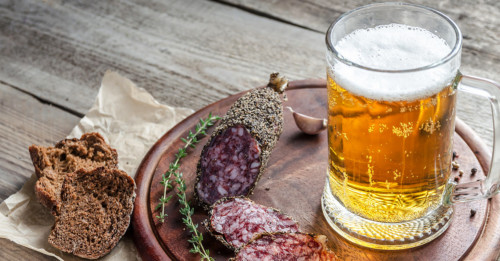There’s plenty of advice out there when it comes to what goes with what (what side dish goes best with Thanksgiving turkey, what purse matches that dress, what catch phrase best exemplifies that action hero’s no-nonsense attitude, etc.). But when it comes to beer and food pairings, what reigns supreme—even over the expert advice—is your palate. You want to pair potato chips, sardines, and stout? Go for it. (Actually, that sounds kind of good…)
That said, there are of course some tried and true guidelines to help you navigate the equally complex and infinitely-expanding worlds of craft beer and cuisine. Pairing beer and food is all about coaxing the most pleasure out of each. And that means we have to consider what elements are at play, such as texture, flavor, aromatics, fat, acidity, sweetness, bitterness, and carbonation, to name a few of the most important.
As with wine, a major question in beer and food pairing is what do you want to do? Food and beverage pairings can complement or contrast, and often do both. If you’ve ever had pizza and a light, hoppy beer, you’ve unwittingly reveled in the way the carbonation and hops cut through the contrasting grease. And that’s just the beginning of it. Hops provide a backbone in beer, and along with carbonation can do a lot of the work that acidity might do in “cutting” through the richness of a dish, which is a great way to create highlighting contrasts. But in certain styles like IPA, hops also have assertive flavors, which may distract too much from the food. In a situation where something too hoppy threatens to overshadow the beer-food partnership, you may be better off going for a moderately hopped pale ale or even a crisp lager.
Hops can also complement, as when a hoppy beer is paired with spicy food, each ratcheting up the intensity of the other (be careful here!). The same is true for something as dramatically rich as stout and stew—each element has rich, often dark flavors (think spice, cocoa, meatiness), but side by side they can sing a beautiful, sultry duet. Then again, you could also go for a slightly sweeter beer to tame the spiciness of your food, or reach for a malty or wheat beer for your next meaty, spicy dish. The possibilities, thankfully, abound.
When in doubt it’s always helpful to go by the most pronounced elements, things like alcohol content, sweetness, and carbonation. Since sweetness is such a pronounced flavor (as is bitterness, on the other side of the coin), it’s fairly easy to tell when your beer or food’s sweetness requires something either complementary (as in pairing a nice coffee porter with chocolate cake) or contrasting (a slightly sweet fruit or lambic paired with rich cheese). Alcohol and carbonation also make themselves known fairly aggressively—which is why having a light broth alongside a high-ABV IPA or serving a crisp, ultra-carbonated lager alongside a steak might seem imbalanced.
But again, your own palate is your best guide, so follow it. And as always with pairings, if at first you don’t succeed, try, try again.
